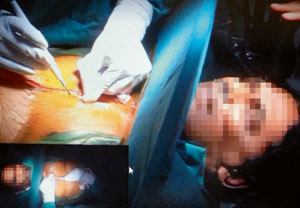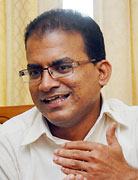Painless surgery -- under the scalpel with chest wide open not just for any operation but major heart surgery.
Not only was it painless but they spoke, they listened to music and also looked up at the reflection of their own heart while the doctors fixed it.
It is the first time that such a procedure has been carried out in Sri Lanka, says Consultant Cardiothoracic Surgeon Dr. G. Gandhiji who performed this meticulous operation along with Consultant Cardiac Anaesthetist Dr. C.V. Uduwela at the Kandy Teaching Hospital.
 |
| A patient undergoing the procedure |
Three patients from Ward 76 have undergone two open-heart surgeries for mitral valve replacement and aortic valve replacement respectively and the third a bypass surgery within January and early February, MediScene understands.
Explaining that such surgery is called ‘awake non-intubated open heart surgery under thoracic epidural anaesthesia’, Dr. Gandhiji stresses that throughout the procedure the patient is fully alert.
Usually epidural anaesthesia is used in Sri Lanka for the delivery of babies under a Caesarian section without administering general anaesthesia, it is learnt. It is a “regional” anaesthesia which is used to block nerve routes spreading from the spinal cord to stop the patient feeling pain in a certain section of the body.
General anaesthesia, as opposed to this, is the administration of a medication to induce unconsciousness, muscle relaxation and loss of sensation all over the body to prevent pain, it is understood.
Heart operations, says Dr. Gandhiji, are traditionally performed under general anaesthesia. “The patient is heavily sedated with medication and unconscious, after which a tube is inserted in the airway and he is ventilated and subsequently put on the heart-lung machine.”
Delving into the pioneering procedure carried out at the Kandy Hospital, Dr. Gandhiji says his colleague, Dr. Uduwela who had seen similar procedures at workshops in India, inserted a catheter in the epidural space in the lower neck in the Intensive Care Unit (ICU). Then the patient was wheeled into the operating theatre and a special needle fixed to a pump sent through the catheter to infuse the anaesthetic locally. This results in the chest area, between the neck and the mid-tummy where the surgeon will work on, becoming numb and pain-free.
 |
| Dr. G. Gandhiji |
This technology used in the west between 2000 and 2005 was later adopted in centres in the east including India, it is learnt.
The patient remains pain-free not only for the nearly three-hour heart surgery but also for two days post-operation, says Dr. Gandhiji.
“Soon after they were moved to the ICU after the operation, they had a drink and biscuits. They also sat up two hours after the operation and walked around the following morning,” he smiles, whereas if they had been put to sleep under general anaesthesia they would have had to wait for the tube to be removed from the throat the next morning to eat.
General anaesthesia would also have left them groggy, confused, headachy and nauseous, MediScene learns. While the anaesthetic could also be toxic for both the kidneys and liver leading to the failure of these vital organs, intubation which entails a tube being thrust down the throat, could cause a host of problems such as damage to the vocal chords and trachea, trauma, ulcers, injuries and bleeding into the lungs. Such haemorrhaging into the lungs may lead to death in the worst-case scenario while the patient may also end up with severe chest infections.
As the thoracic epidural anaesthesia acts only on the target, according to this Cardiothoracic Surgeon, the patients also looked comfortable soon after the operation. Discomfort due to general anaesthesia can cause stress with hormonal action rising, followed by other complications. This new procedure, however, reduces the time they need to spend in the ICU as they can be moved to the ward the next morning.
“No special equipment except a catheter and fewer drugs are needed. The turnover time is less because of lesser ventilation time,” stresses Dr. Gandhiji, pointing out that they would be able to clear the waiting list for heart operations sooner.
Referring to the operations themselves, he explains how a scalpel is used to cut away the skin on the chest above the breast bone after which the bone is opened up with an electric saw to get access into the chest cavity where the heart is located.
When dealing with blocked or diseased coronary arteries, firstly the conduits which will bypass them must be harvested, says Dr. Gandhiji. Such harvesting is done from the hand where the radial artery is located, from the leg where the vein is or the internal mammary artery from the under surface of the breast-bone.
Coronary artery bypass surgeries can be done with the heart being on pump or off-pump, it is understood.
“On pump entails the patient being put on the heart-lung (cardiopulmonary bypass) machine where his heart is stopped by injecting a solution, then ice placed on it to cool it and the diseased coronary artery is bypassed with the harvested one and anastomosed (joined).
All this while the heart’s action is carried out by the machine giving time for the surgeon to work,” says Dr. Gandhiji. When the surgery is over the solution injected to stop the heart is flushed out to allow the heart to resume beating. Thereafter, the heart lung machine is slowly weaned off allowing the patient’s own heart-lung to take over. At the end with the aid of steel wires, the chest is closed up.
Off-pump is more difficult to deal with as the surgeon has to do so while the heart is beating, using a stabilizing device called the octopus to still only the specific area of the heart which he is working on, he adds.
The mitral valve and aortic valve replacements were done on-pump, with cardioplegic arrest, says Dr. Gandhiji, only mildly acknowledging that it is meticulous and minute work. |
